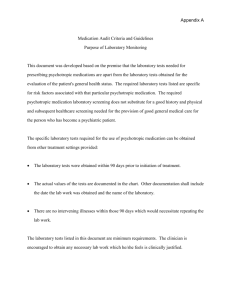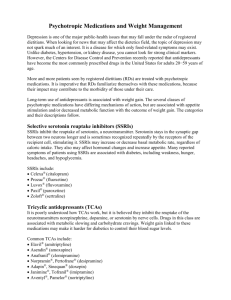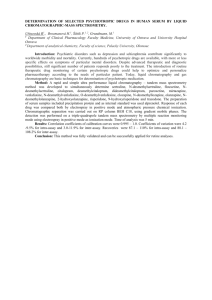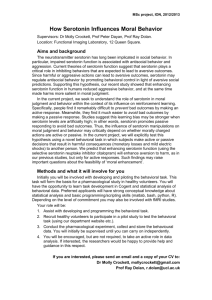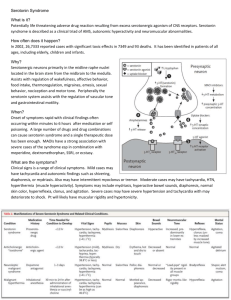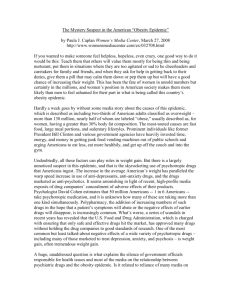Alfred Pletscher by Andrea Tone
advertisement
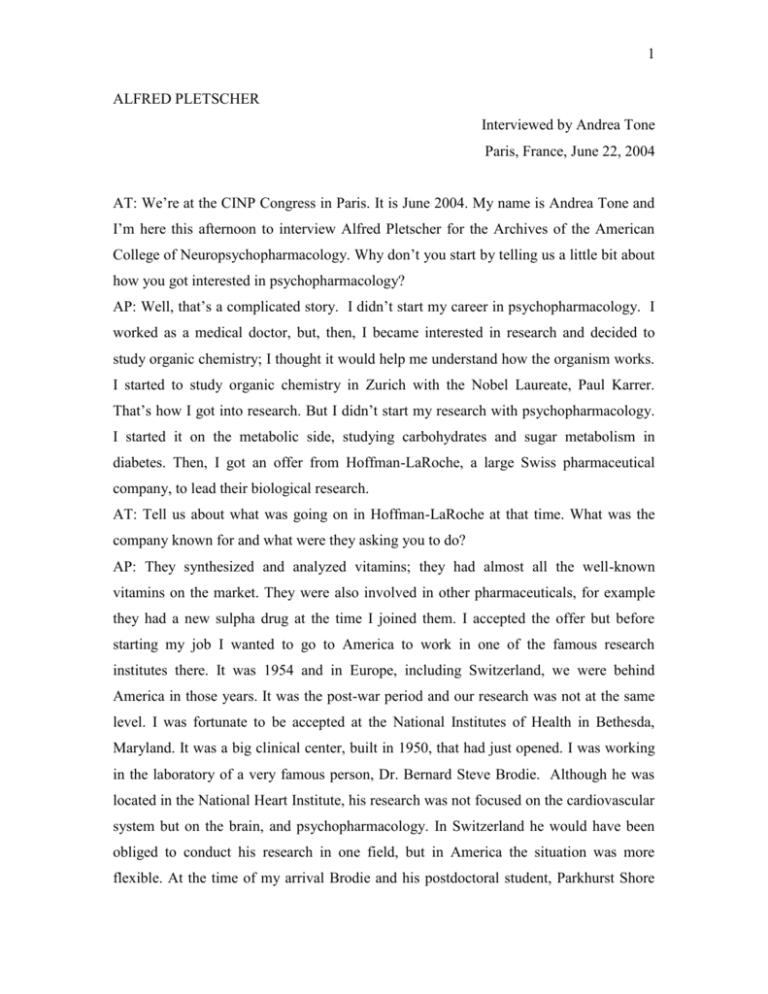
1 ALFRED PLETSCHER Interviewed by Andrea Tone Paris, France, June 22, 2004 AT: We’re at the CINP Congress in Paris. It is June 2004. My name is Andrea Tone and I’m here this afternoon to interview Alfred Pletscher for the Archives of the American College of Neuropsychopharmacology. Why don’t you start by telling us a little bit about how you got interested in psychopharmacology? AP: Well, that’s a complicated story. I didn’t start my career in psychopharmacology. I worked as a medical doctor, but, then, I became interested in research and decided to study organic chemistry; I thought it would help me understand how the organism works. I started to study organic chemistry in Zurich with the Nobel Laureate, Paul Karrer. That’s how I got into research. But I didn’t start my research with psychopharmacology. I started it on the metabolic side, studying carbohydrates and sugar metabolism in diabetes. Then, I got an offer from Hoffman-LaRoche, a large Swiss pharmaceutical company, to lead their biological research. AT: Tell us about what was going on in Hoffman-LaRoche at that time. What was the company known for and what were they asking you to do? AP: They synthesized and analyzed vitamins; they had almost all the well-known vitamins on the market. They were also involved in other pharmaceuticals, for example they had a new sulpha drug at the time I joined them. I accepted the offer but before starting my job I wanted to go to America to work in one of the famous research institutes there. It was 1954 and in Europe, including Switzerland, we were behind America in those years. It was the post-war period and our research was not at the same level. I was fortunate to be accepted at the National Institutes of Health in Bethesda, Maryland. It was a big clinical center, built in 1950, that had just opened. I was working in the laboratory of a very famous person, Dr. Bernard Steve Brodie. Although he was located in the National Heart Institute, his research was not focused on the cardiovascular system but on the brain, and psychopharmacology. In Switzerland he would have been obliged to conduct his research in one field, but in America the situation was more flexible. At the time of my arrival Brodie and his postdoctoral student, Parkhurst Shore 2 had just found indirect evidence that reserpine, used at the time in the treatment of schizophrenia, might act on serotonin, in the brain. AT: Do you think many of those early discoveries came about simply by accident? AP: Many discoveries come by serendipity but in this case the indirect evidence was based on sophisticated experiments. At that time people had no idea of what causes depression, euphoria, or anxiety, and nobody knew anything about the mechanism of action for psychotropic drugs. It was from indirect evidence in these and other experiments that it was suspected there might be a chemical in the brain behind pathologies like depression that was acted on by a drug. It might be! This was a very revolutionary idea. Many psychiatrists in those days said that was mere speculation. So, I was given the task to provide direct proof that reserpine releases serotonin, in the brain. AT: Did your company want you to do that? Were they aware of the importance of the research? AP: Hoffman-LaRoche was located in Nutley, New Jersey and I was in Bethesda. There was no biochemical method available for the detection of serotonin in those days so my first task was to develop a chemical method that could do that. I worked first in the gastrointestinal tract because it was known that the greatest amount of serotonin occurred in the gut. It was present in a ten times higher amount than in the brain. After I worked out the method, I started experiments with rabbits, injecting them with reserpine. What I found was that the serotonin content, measured in the morning, went down. AT: How did you measure the serotonin content? AP: It was a colorimetric method, primitive, but specific. I had to show this occurred, not only in the gut, but also in the brain. So, I had to work out a method that was three times more sensitive than the one I used before. This was the time a highly sensitive spectrophotofluorimeter, constructed by Bowman, Caulfield and Udenfriend in another laboratory of NIH, became available so I could use it first in my experiments. AT: Were you still in Bethesda doing these experiments? AP: I was at the National Institutes of Health with Brodie, and under his guidance I was doing these experiments. Parkhurst Shore helped me, but I was doing the research myself. I found, with this new instrument, that after reserpine the serotonin in the hypothalamus disappeared. Parallel to the decrease we noted that the animals became sedated. Then, 3 after repletion of the serotonin stores in the hypothalamus, the behavior of the animals normalized. The reserpine-induced behavioral changes were immediately tied to changes in the level of serotonin. If there was no serotonin, there was sedation. If there was enough serotonin, the animals were normal. Later on, it was found by others that reserpine depleted other neurotransmitters, like noradrenalin and dopamine. It was Arvid Carlsson in Goteborg, who discovered that reserpine depletes the other monoamine neurotransmitters. Our findings indicated that at least the action of one psychotropic drug was mediated by a chemical neurotransmitter in the brain. AT: It provided an empirical foundation for the development of psychopharmacology. AP: Yes, it was one of the important findings that provided a basis for development of the field. At the same time Hoffman-LaRoche had a drug, called, iproniazid that was to become the first of a series of antidepressants referred to as monoamine oxidase inhibitors. Iproniazid is an inhibitor of the enzyme, monoamine oxidase that is important for the metabolism of the neurotransmitters, serotonin, norepinephrine and dopamine, in the brain. It was Albert Zeller at Northwestern University in Chicago, who found that iproniazid caused inhibition of monoamine oxidase. Almost at the same time Nathan Kline, the head of a Psychiatric Institute in New York State, recognized the drug had a favorable effect in patients with depression. It was the first evidence that a MAO inhibitor was effective in depression. As an employee of Hoffman-LaRoche, working at the National Institutes of Health, I took iproniazid and injected it into rabbits. What did I see? Serotonin levels instead of going down, as with reserpine, went up. Then, when I injected iproniazid before reserpine, the serotonin-decrease was antagonized. So I could say the antidepressant effect of iproniazid was possibly mediated by the neurotransmitter serotonin. This defined our theory that psychotropic drugs did not produce their psychological effect out of the blue, but had a biochemical basis. I played a role in that I did the initial experiments, which brought proof that the psychotropic effect of reserpine is mediated by a neurotransmitter, and I provided experimental evidence with iproniazid that the theory regarding the role of neurotransmitters in psychotropic effects was right. AT: How involved was the company at this point in the development of an antidepressant? Was there even a market for them? 4 AP: They started to market iproniazid, the first monoamine oxidase inhibitor antidepressant and the sales went up very, very well. Then, all of a sudden, there was a drop in sales. What happened was that a patient in California, who had taken iproniazid, got liver necrosis and was transferred to New York where they made a big story out of it. My wife and I were riding in a bus from New York City to Montclair on a Saturday afternoon, and in front of us was a guy reading the New York Times. I sneaked a peak at the headlines over his shoulder that said: Inspectors Come to City to Ban Deadly Drug. I also saw it was iproniazid; my drug. Later on I heard of other cases of liver damage but although iproniazid was taken off the market other monoamine oxidase inhibitors continued to sell quite well. So they must have been good drugs for the treatment of depression. AT: Do you think the condemnation of the drug was exaggerated? AP: All public outcries are probably exaggerated by the media. They exaggerate to attract attention. It was certainly something unique that happened. One, of course, has to be very cautious with MAO inhibitors. But, as you know, there are two types of monoamine oxidase enzymes; nowadays we have inhibitors which act more specifically on the Type A and others which act more on the Type B enzyme. That can mitigate some of the side effects. AT: When Hoffman-LaRoche put the drug on the market, did they do so with the expectation that there would be a large demand for antidepressants? AP: Of course. AT: Some historians have argued that in the 1950’s, it was anxiety, rather than depression that sold the drugs. Hoffman LaRoche would later be best known for benzodiazepines in anxiety. Were they confident in the 1950s about the marketability of an antidepressant? AP: Yes, of course. Thousands of people have been in psychiatric hospitals for depression. And depression can be stubborn in responding to treatment. It was foreseen antidepressants might have a big market and in the beginning, the sales of iproniazid were very good. AT: In hospitalized patients or outpatients? AP: For hospitalized patients first. But, then it was marketed for outpatients, and used in general practice. 5 AT: Do you remember how it was marketed? AP: It was called Marsilid; that was the trade name of iproniazid. AT: You stayed with Hoffman-LaRoche until when? AP: 1978. AT: Tell me about what you did with the company for the rest of the time. AP: I was in charge of biological research and then of worldwide research. When I returned from the National Institutes of Health to start my job with Hoffman-LaRoche in Basel I told top management that the primary area of research must be psychotropic dugs because that was the upcoming field. So, in chemistry and biology, on both sides of the ocean, research for many years was focused on the development of psychotropic drugs. AT: Was that a hard sell or were they receptive to the idea? AP: They were receptive. They believed me and saw there might be a growing market for psychotropic drugs. Then came the fortunate discoveries of chlordiazepoxide (Librium), and diazepam (Valium). That is a nice story, too. There was a chemist, Leo Sternbach in Nutley, who came from Poland and, as a postgraduate student, synthesized several heptoxydiazapines in the 1930s. Then, in the early 1950s, while working with the company he synthesized more of these seven-ring compounds but it seemed nothing was coming out of it because the compounds were biologically inactive. The project was about to be abandoned but one of the last compounds synthesized he gave to the biologists to see whether there was something in it. Fortunately, the biologist injected the compound into rats and cats and found it produced sedation without sleep. While the known sedative drugs at the time, like phenobarbital, caused sleep and sleepiness in higher doses, this drug, that was to become know as chlordiazepoxide, was causnig sedation without producing sleep. I remember a demonstration by the pharmacologist that after injecting it to a colony of very violent cats they became pussycats. They went around your legs, purred and were very nice, but most importantly they didn’t sleep. That was very interesting. AT: Hoffman-LaRoche was pursuing the development of psychotropics because, in the 1960’s, when Librium was approved by the FDA, meprobamate (Miltown, Equanil), was consumed by 1 in 6 Americans. Was the company involved in directing researchers 6 toward lucrative paths, or was it the scientists, like you, who were saying we need to work on psychotropic medicines? AP: They were scientists in top management like me who believed that psychotropic drugs were the future. So, the question was what type of psychotropic drugs? We were already into monoamine oxidase inhibitors. We pursued our research with MAOIs mainly in Basel, although we did some work in that area in Nutley. In Nutley they had the facilities to screen for psychotropic drugs. The discovery of the unique properties of Librium was a serendipitous finding in biological testing. Sternbach knew he synthesized an interesting new compound but he didn’t know whether the drug had biological action. The biologists who discovered Librium has a novel pharmacological action stimulated Sternbach to synthesize analogues. Some of these were found to have advantages over the parent substance and were also developed for clinical use. Another interesting aspect of the Librium story is related to my appointment in 1958 as Scientific Director to reorganize the Research Institute in Nutley. At the time of my arrival some of the early pharmacological research with Librium was already done and the pharmacologists were very interested in developing the substance clinically whereas the management was not. When I told management we had a compound that causes sedation, the response of both the president and the research director was that we needed a strong hypnotic and not a weak sedative. But, regardless of the opinion of management, we moved ahead with clinical trials with Librium. The success was enormous from the beginning. AT: That’s very interesting. They were more interested in a hypnotic than in an anxiolytic? AP: Yes. An important part of the story is that Librium was developed clinically because we pushed it in spite of lack of interest by management. AT: Let me, ask a couple of questions and, then, I’ll invite you to say anything you would like to add. You said in the piece you did for the final volume of the CINP collection, that when you went into industry, you had misgivings about what working for a company might offer versus working independently. Looking back on your career, do you still have any misgivings about working for industry? AP: No, I don’t have any misgivings at all. If you decide to go to work for industry you have to make some compromises. One is that you have to pay for research from money 7 you generate from your success. So you cannot work on all the different drugs you are interested in. You have to work on drugs that have a big market to generate money. But you can do wonderful research in the pharmaceutical industry, much more than at a university or in public and state institutions. At Hoffman- LaRoche, we had an especially good situation. We could do almost everything we wanted. We were free in our research, but we were expected to have in the back of our minds that we had to bring in money to do what we wanted to do. This was the reason I did not pursue my interest in developing drugs against malaria or tropical sleepiness and decided we should work on the development of drugs for the treatment of depression and schizophrenia. AT: Within those boundaries you felt you had a lot of flexibility? AP: I had a lot of freedom, and I was happy. But I don’t know how it is nowadays. If they had prevented me from doing my work to develop a drug that was seen by management as a weak sedative, or to develop psychotropic drugs in general, I would have left. But remember, in spite of the lack of interest by top management in a “weak sedative,” as Librium was perceived to be we were able develop it. AT: It’s a good thing you advocated it. AP: Yes. AT: What was your most significant contribution to psychopharmacology? AP: My success in developing therapeutically effective psychotropic drugs. When I joined Hoffman-LaRoche the company had a sulfa drug, Gantrisin that had yearly sales amounting to six million dollars. But when Librium was introduced it had yearly sales of almost a hundred times that volume. AT: Is there anything that you would like to add to this interview? AP: Well, I had another interest in which I invested much time. I was looking for a peripheral model of serotonin release and uptake in humans. Working in this area of research in collaboration with the National Institute of Health we found that blood platelets have similar mechanisms for the release and uptake of serotonin as the central nervous system. AT: Thank you very much for a wonderful interview. AP: My delight.
